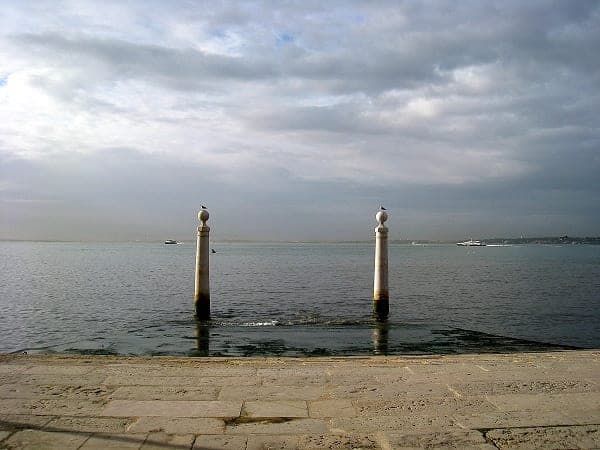This post is a self-guided walking tour of Lisbon, specifically the downtown area of Baixa, along with a map and audio option.
It covers some of the most interesting things to see when you visit this picturesque neighborhood in Lisbon.
Additionally, we have self-guided walking tours for Chiado/Alto Bairro, Alfama, and Belém.
Everything listed here is part of Day 1 of our 3-day Lisbon itinerary.
Click on the map to expand or to download to a smartphone.
We also have free guided walking tours of Lisbon.
What is Baixa?
In the heart of Lisbon lies the Baixa district.
This low area between two hills of the city was rebuilt after an earthquake and tsunami devastated the area in 1755.
Today, Baixa, with its series of squares and classical avenues, is made up of restaurants, cafes, tourist-friendly shops, and art galleries, museums, and pedestrianized streets.
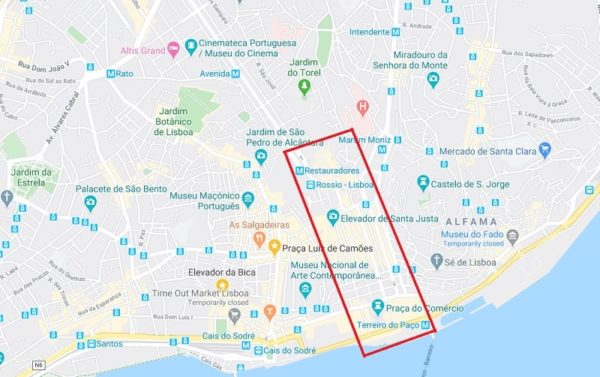
HOW TO GET HERE
The district is rather long with several tram lines and Metro lines serving it. For simplicity's sake, we will focus on the starting point of this tour (map).
The closest Metro Station is Terreiro do Praco (Az).
Two other stations are within reasonable walks from the start, Baixa Chiao (Az) + (Vd), as well as, Cais do Sodré (Vd).
The following trams have stops nearby: Trams #28E, #15E, + #12E.
There are also numerous bus lines that service the area.
Cais do Sodré is a train station that connects the Baixa with Belem. If you are coming from that direction, there is also tram #18E.
GPS-Enabled Audio Tour
We offer an audio tour of Bairro Alto/Chiado/Baixa, researched, written, and recorded by one of our own tour guides.
Here’s a sample.
- Purchase an audio tour.
- Get a confirmation email with .mp3, .pdf and embeddable Google Map
- Enjoy the tour(s).
WARNING: The audio enters Baixa from the other end of this self-guided tour below.

You could also take part in one of the free walking tours that cover this area.
1. Cais Das Colunas
The beginning of the Baixa tour starts at the Cais das Colunas (map).
This quay, named after the columns on its edge, was built in the late 1700s. The columns are said to represent wisdom and devotion.
It was through these columns that dignitaries would pass through on their way to the castle, including Queen Elizabeth in 1957.
2. Praça do Comércio
This plaza, in English known as the Square of Commerce, represents the wealth of Lisbon.
It was here that finances and trade, much of it coming from the sea, thrived.

This square, along with the entire area of Baixa, was destroyed in the great earthquake and tsunami of 1755 but has been rebuilt to show the resilience of Lisbon’s people.
The statue in the middle of the square celebrates King Jose I, the ruler who oversaw this rebuilding, with the horse trampling snakes at his feet.
3. Lisboa Story Centre
The museum provides an audio and visual history of the city of Lisbon.
In only 60 minutes one is taken back in time to visit key events in six areas of her history, areas that have shaped the city into what it is today.
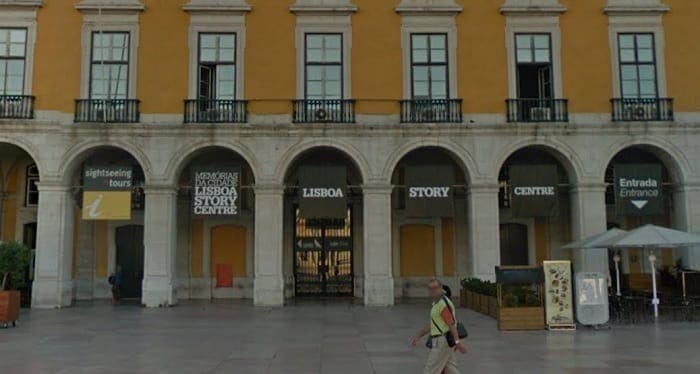
Hours: Every day from 10:00 to 20:00 (6 pm)
Tickets:
- €7 Adult
- €5 Seniors
- €5 Students ages 16 and above
- €3 Children ages 6-15
- €0 Children ages 5 and under
- €18 Families of 2 adults and 2 children
- Group ticket pricing is also available.
An audio guide is included in the price of each ticket. Learn more on the official website.
4. Arco da Rua Augusta
This stone arch, erected over 100 years after the earthquake, standing to the edge of the Praça do Comércio is a symbol of Lisbon’s recovery.
Historical figures decorate the arch with those at the top representing Valor and Genius.

Visitors can ride an elevator most of the way to the top and then climb the rest of the way.
Here you’ll find amazing 360-degree views of the city.
- Hours: Every day from 10:00 to 20:00 (8 pm)
- Tickets: around 3€
Tickets can also be purchased ahead of time here.
5. Museu do Dinheiro (Money Museum)
This museum is housed in a former church.
Inside you’ll find displays covering the concept and evolution of money, a bank vault, a length of King Dinis’wall from the 13th century, samples of money from both the past and from around the world, money-making equipment, and more.
Hours:
- Monday-Tuesday CLOSED
- Wednesday-Sunday 10:00 to 18:00 (6:00 PM)
Tickets: free
6. MUDE
The Design and Fashion Museum (MUDE) includes the works of hundreds of designers from around the world including such well-known icons as Charles Eames, Jean-Paul Gaultier, and Yves Saint Laurent.
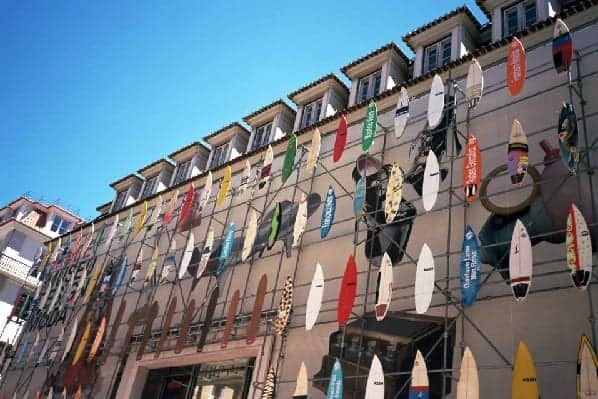
Everything from furnishings to jewelry to couture pieces can be found within its fashionable walls.
Hours: Currently Closed for Renovations
Check out the official website for updates.
7. TRAM 28E
Delightful is a word sometimes used to describe Lisbon’s antique trams. Tram 28E winds its way through some of the most popular tourist areas.
One sees the hills of Graca, then down to the old quarter Alfama, across the downtown area of Baixa, towards Estrela, and finally ending in Campo Ourique in the historic center of Lisbon.
This tram is used by locals but gets packed by tourists. Wait times can be long.
- Hours: 7:30-21:15 (9:15 PM)
- Tickets: €2.50 - single
A better price can be found with a 24/48/72 hour public transport ticket that covers all buses and trams. To read more about discount cards, read our post here.
8. Núcleo Arqueológico da Rua dos Correeiros (Fundação Millennium BCP)
Known by the acronym NARC, this site is another that takes you through 2,500 years of Lisbon’s development.
Beneath a bank lies the results of archeological excavations that took place in the 1990s including tanks belonging to a Roman fish sauce factory, ceramics, mosaic floors, Islamic ceramics, remnants of the earthquake disaster, and more.
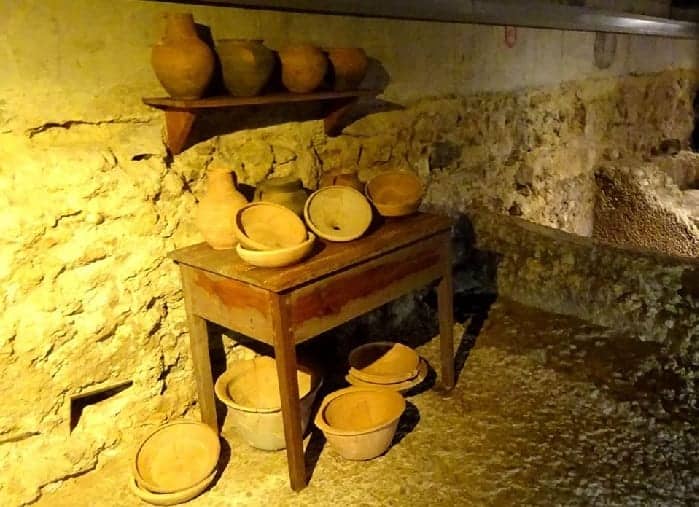
Hours:
- Sunday: CLOSED
- Monday-Saturday: 10:00-12:00 and 14:00-17:00 (2:00-5:00 PM)
Tickets: Free Admission
Guided tours take 45 minutes to 1 hour.
Learn more at the official website.
9. Rua Augusta
Rua Augusta, a Moroccan tiled pedestrian walkway just off of Praça do Comércio, is surrounded by buildings that reflect the 18th-century Pombaline style of architecture.
This style came with a number of at-the-time innovative systemizations in the way structures in Baixa was put up and the streets and walkways laid out.

Most importantly, these buildings were constructed to prevent as much earthquake damage as possible, Baixa having been one of the most devastated areas after the 1755 quake and Tsunami.
Due to the economic conditions of the time, the facades in this style are more austere with little way of decoration.
It was only in the late 18th century that a more eclectic style of Neoclassical and Romantic started to make an appearance, seen at the end of the street in the Arco da Rua Augusta.
10. Igreja de São Nicolau
Exquisite ornamentation is the best way to describe what you’ll find in this still-active religious site.
This Catholic neo-classical/baroque church was built in 1762, replacing previous churches built on the same site.

Here one finds colorful ceiling murals, jewelry ringed hanging lights, ironworks, St. Nicolas’ image in limestone, scrollwork, and stained glass.
11. Santa Justa Lift
The most ornate, neo-Gothic elevator you have likely come across, the Santa Justa lift, now at over 100 years old, was built to transport folks from lower to upper Lisbon.
The designer was a fan of Gustav Eiffel and sought to emulate the Eiffel Tower with this wrought iron structure.
One makes the trip in a wood-decorated elevator car, up to one of her two levels.
Hours: 7:00 to 22:45 (10:45 pm)
Tickets:
- €5.15 Return on the elevator to the lower deck
- €1.50 to travel on the elevator to the top deck unobstructed viewpoint
Discounts can be had with the Viva Day Pass or Lisboa Card. Get more information on the official website.
12. Praça Dom Pedro IV
The square is in the center of Lisbon, both in location and in the heart of locals.
In the center sits a column dedicated to Pedro IV who briefly reigned over Portugal and then became the first ruler of what is now Brazil.
The bottom of the columns holds allegorical figures representing Moderation, Strength, Justice, and Wisdom, all attributes the King was said to possess.
Locals refer to the square as just “Rossio” (meaning common land). For 700 years a plaza has stood at this site, home to everything from bullfights to public executions.
Today one will find famous cafes, restaurants, shops… and a dizzying tiled pattern, much like waves, said to pay tribute to the city’s seafaring past.
Take Lisboa starts their free Alfama and Mouraria tour here and all of Live Lisbon Tours free tours begin from here as well.
For an overview of all free walking tours in Lisbon, visit our post.
13. Praça da Figueira
Another square near the center of Lisbon, Praça da Figueira (Fig Tree Square) is known for its open-air market.
Here you’ll find locals and tourists enjoying inexpensive drinks and traditional foods.
Vendors sell bread, cheese, cured meats, wine, fruits, and various touristy items.
Rolls with ham and cheese, pasteis de nata, cakes, and fresh orange juice, can be found at Mercado da Figueira, a bakery on the square that’s not to be missed.

In a corner of the square stands a bronze statue of King John I astride a horse.
He served on the throne for 48 years, was celebrated for helping to preserve his country’s independence, and was known for his benevolence and wit.
It’s a little run down and it can be hard to find a seat when it’s busy. But it’s said to have a worn charm to it.
You’ll also find it a transportation hub and a place to pick up tuk-tuks, trams, and taxis. Tram 15E departs from here for Belem every 10-15 minutes.
You can also catch Tram 12E which heads up to Saint George’s Castle, which is an alternative to the more popular Tram 28E.
14. Igreja de São Domingos + Largo Sao Domingoes
Igreja de São Domingos is the largest church in Lisbon and one first dedicated in 1241. It sits on Largo Sao Domingos square.
Here there have been royal marriages and christenings and other usual church activities.
The church itself has withstood two earthquakes and a tidal wave, including the one that devastated most of Baixa.
A fire eventually destroyed the interior of the church in 1959, closing the church for almost 40 years.
Today one finds the raw beauty of destroyed grandeur upon entrance.
The pillars holding up the roof are cracked and fire-scarred (one can still smell the odor of fire) and the plaster walls are damaged and peeling.
Yet here, in a place bereft of the usual churchly perfection, one finds an intriguing mix of architectural styles and an atmosphere befitting such solemn grounds.
15. A Ginjinha
A Portuguese landmark, this small outdoor hole-in-the-wall shop is worth a visit. Here you’ll find Ginjinha, the traditional alcoholic drink of Portugal.
For €1.4 you can have a shot of this cherry liquor (Cherries fermented in Brandy, sugar, water, and cinnamon), served with or without cherries on top.
You’ll likely spot long lines although they move quickly. Read the reviews on its Yelp page.
16. The Estação do Rossio
This stunning train station, designed in the late 1880s, was built near and eventually named after one of Lisbon’s most popular squares, The Rossio.
At the time it was considered a feat of modern engineering, with tunnels that connected national and international trains to the center of the city.
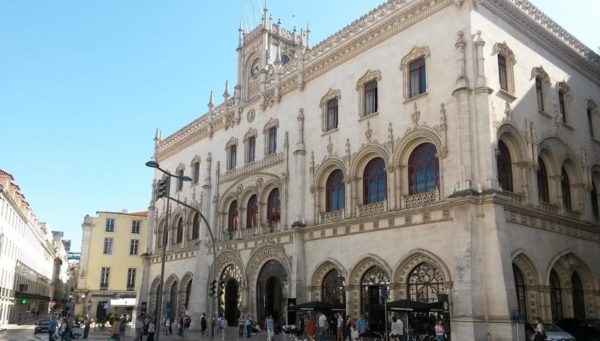
The stunning facade is Neo-Manueline, often considered the most authentic Portuguese style. Elaborate stonework surrounds the windows.
Horseshoe-shaped entrances, with intricate carvings of maritime motifs, line the entrance walls along with cast iron windows, cast iron is a new material at the time of its construction.
A small turret and ornamental clock crown the top of the building.
Trains leave often for Porto, Sintra, Rossio, and farther-flung locales. Ticket machines can be busy, so at peak times it’s best to make an early start.
17. Monumento aos Restauradores
This monument, an obelisk, commemorates Portugal's independence from Spain after 60 years of rule.
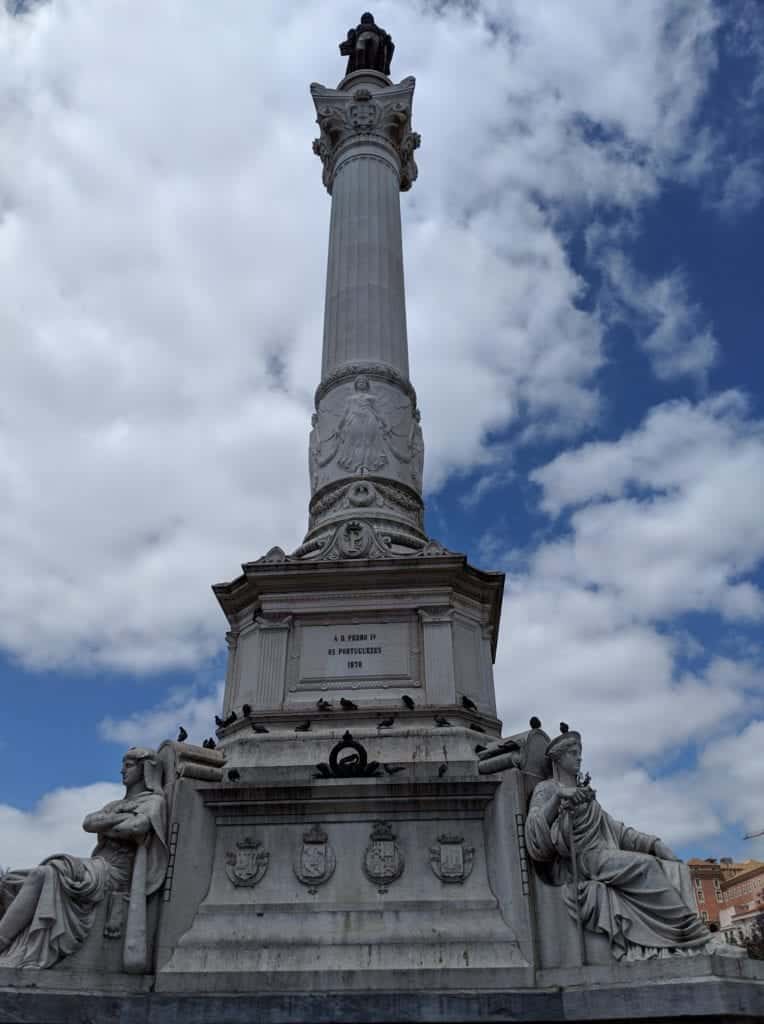
It was built in the center of Praça dos Restauradores Square in 1886 and honors those soldiers who died during the various battles to restore sovereignty.
Statues symbolizing Independence and Victory are in this monument, one dedicated to the restorers of both.
18. Teatro Eden
Opened as a cinema for silent movies in 1931, this stunning example of art deco design is one not to be missed.
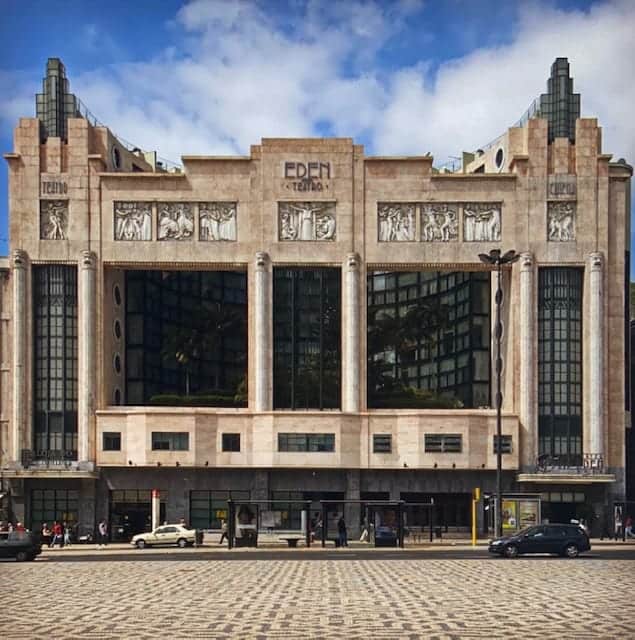
Although parts of the building were destroyed due to neglect and eventual renovation, the original facade remains.
19. Gloria Funicular
Designed by the same man who designed the Santa Justa Lift, these cable cars ferry city dwellers up the steep slopes of the city.
The Elevador da Gloria is the most popular of the cars and is often packed with tourists and locals.
The tram climbs up past Graffiti painted walls, close to flats, quickly taking riders from Restauradores Square to one of the best spots in the city to get pictures.
- Hours: 7:30-21:15 (9:15 PM)
- Tickets: €3.70 each way.
20. Miradouro de São Pedro de Alcântara
Although one can walk from Restauradores Square up R. de Soar pedro de Alcantara, most chose to take the Gloria Funicular up the steep hill.
At the top one finds a (well-reviewed) cafe, a garden with seating, statues, and one of the best views in Lisbon.
From here you can see the castle, the ocean, and the red roofs of Lisbon dotted across the horizon.
OTHER LISBON NEIGHBORHOOD GUIDES





